Chinese Business Etiquette Analysis as per Hofstede’s Cultural Dimension
VerifiedAdded on 2023/06/13
|7
|2027
|178
AI Summary
Mary, an Australian business owner, wants to expand her business to China. To conduct business in China, Mary needs to understand Chinese business etiquette for making a positive impression. This analysis explores the cross-cultural communication gap by incorporating Hofstede’s Cultural Model. It discusses the social dimensions of culture that vary across cultures in Australia as compared to China.
Contribute Materials
Your contribution can guide someone’s learning journey. Share your
documents today.
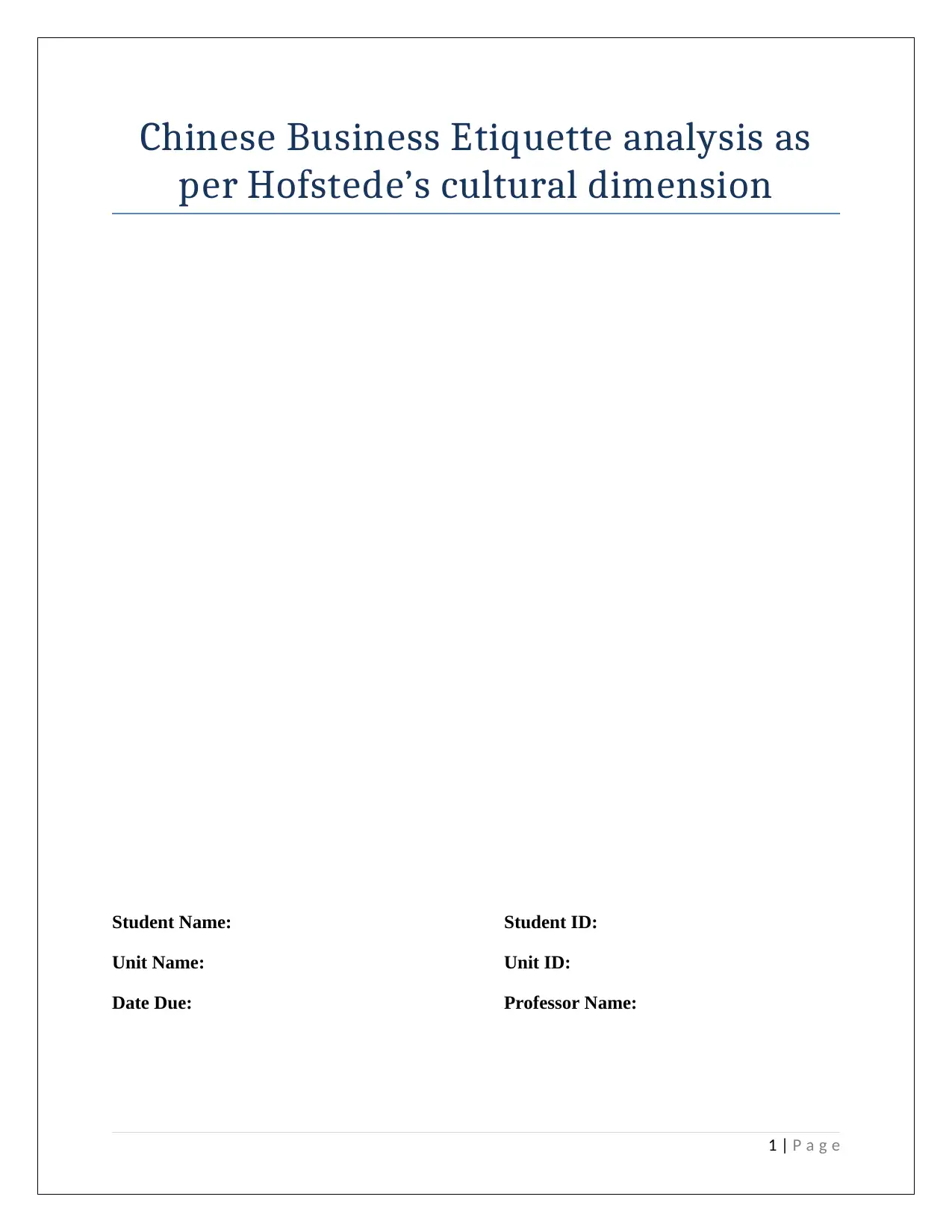
Chinese Business Etiquette analysis as
per Hofstede’s cultural dimension
Student Name: Student ID:
Unit Name: Unit ID:
Date Due: Professor Name:
1 | P a g e
per Hofstede’s cultural dimension
Student Name: Student ID:
Unit Name: Unit ID:
Date Due: Professor Name:
1 | P a g e
Secure Best Marks with AI Grader
Need help grading? Try our AI Grader for instant feedback on your assignments.

Introduction
Business etiquette becomes critical to understand in cross cultural settings (Leung et.al.,
2011). In this business case analysis, Mary, an Australian owns “The Aroma Shop” with small
factory in Wagga Wagga, has decided to expand her business to China. She has decided to meet
her business partner Mr. Lau based in China. In order to conduct business in China, Mary needs
to understand Chinese business etiquette for making positive impression. Mary has to understand
cross-cultural communication gap by incorporating Hofstede’s Cultural Model (Hofstede, 2011).
This will increase business effectiveness and success of meeting.
Analysis
Chinese business framework differs highly in cross-cultural framework and in their cross
cultural communication as compared to Australia. Hofstede’s cultural dimensions as individual-
collectivism, masculinity-feminity, uncertainty avoidance and power distance (De Mooij &
Hofstede, 2010). These social dimensions of culture vary across cultures in Australia as
compared to China. Australia is a westernized democratic society whereas China is an Asiatic
society with a conservative outlook. Business ambience differs in both the countries, hence
following such cultural traditions while operating in China can lead to business success. Firstly
power distance index (PDI) is an index that defines power distribution. In Australia power is
distributed evenly, as a junior person can easily question the authority of a senior member. In
organization or across business relationships, power is evenly distributed in Australia. There are
more open lines of communication amongst business participants with limited gaps in their lines
of communication (Jin Hoare & Butcher, 2008). In China power is not distributed evenly, and
juniors are expected to show respect towards decision of seniors. Business partners are expected
to provide respect to other business partners in various manners as by arriving in time,
composure at business opportunities. However, it is best to avoid much emotion during a
business meeting. Implying, Mary will have to adhere to professionalism strictly while meeting
with her business partner. Moreover, Mary will have to maintain steady lines of communications,
indulging in small talk whilst dealing in her business meeting (Minkov & Hofstede, 2011). A
potential area for miscommunication can exists in case Mary carries gifts or expresses her
appreciation in case of closing of a business deal, which is greatly disliked by Chinese business
2 | P a g e
Business etiquette becomes critical to understand in cross cultural settings (Leung et.al.,
2011). In this business case analysis, Mary, an Australian owns “The Aroma Shop” with small
factory in Wagga Wagga, has decided to expand her business to China. She has decided to meet
her business partner Mr. Lau based in China. In order to conduct business in China, Mary needs
to understand Chinese business etiquette for making positive impression. Mary has to understand
cross-cultural communication gap by incorporating Hofstede’s Cultural Model (Hofstede, 2011).
This will increase business effectiveness and success of meeting.
Analysis
Chinese business framework differs highly in cross-cultural framework and in their cross
cultural communication as compared to Australia. Hofstede’s cultural dimensions as individual-
collectivism, masculinity-feminity, uncertainty avoidance and power distance (De Mooij &
Hofstede, 2010). These social dimensions of culture vary across cultures in Australia as
compared to China. Australia is a westernized democratic society whereas China is an Asiatic
society with a conservative outlook. Business ambience differs in both the countries, hence
following such cultural traditions while operating in China can lead to business success. Firstly
power distance index (PDI) is an index that defines power distribution. In Australia power is
distributed evenly, as a junior person can easily question the authority of a senior member. In
organization or across business relationships, power is evenly distributed in Australia. There are
more open lines of communication amongst business participants with limited gaps in their lines
of communication (Jin Hoare & Butcher, 2008). In China power is not distributed evenly, and
juniors are expected to show respect towards decision of seniors. Business partners are expected
to provide respect to other business partners in various manners as by arriving in time,
composure at business opportunities. However, it is best to avoid much emotion during a
business meeting. Implying, Mary will have to adhere to professionalism strictly while meeting
with her business partner. Moreover, Mary will have to maintain steady lines of communications,
indulging in small talk whilst dealing in her business meeting (Minkov & Hofstede, 2011). A
potential area for miscommunication can exists in case Mary carries gifts or expresses her
appreciation in case of closing of a business deal, which is greatly disliked by Chinese business
2 | P a g e
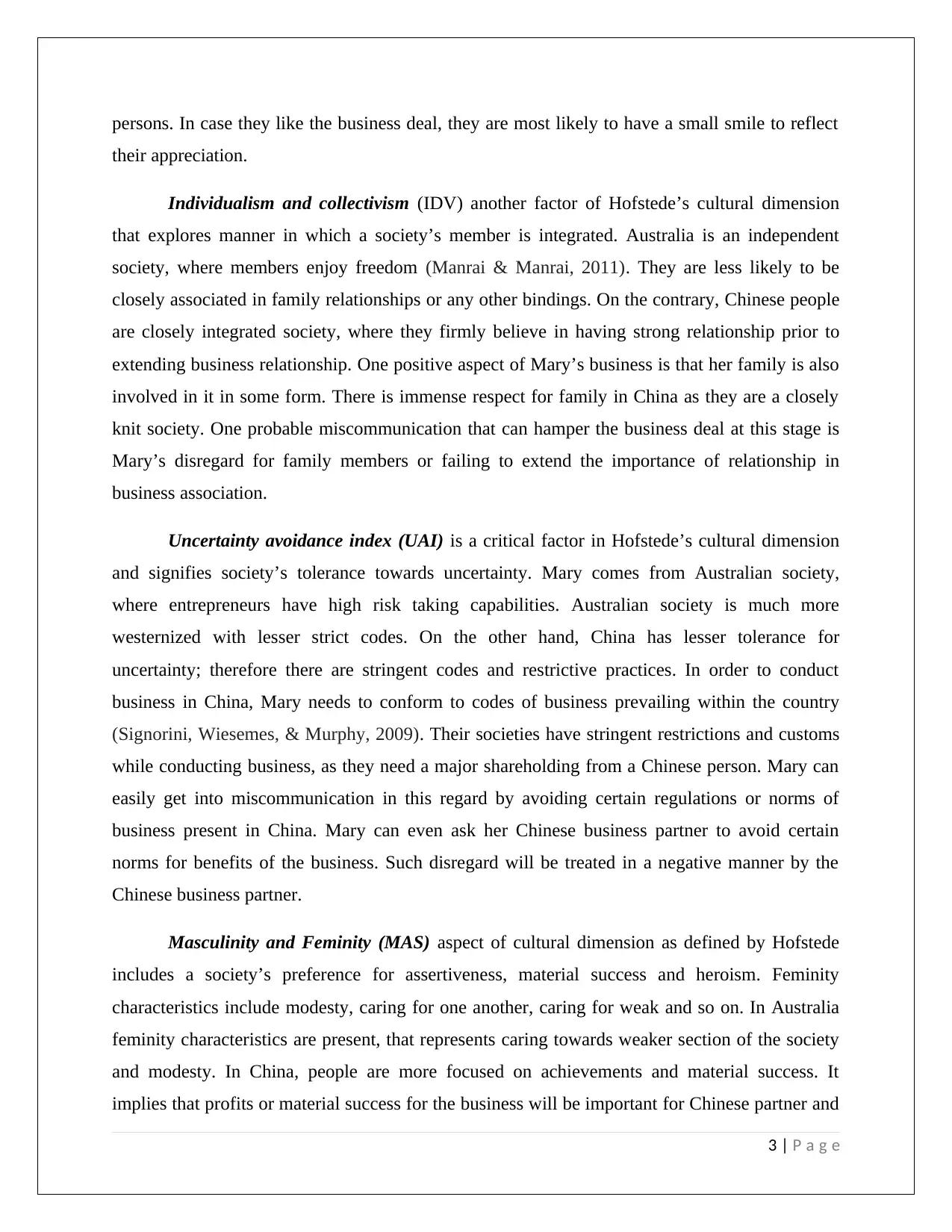
persons. In case they like the business deal, they are most likely to have a small smile to reflect
their appreciation.
Individualism and collectivism (IDV) another factor of Hofstede’s cultural dimension
that explores manner in which a society’s member is integrated. Australia is an independent
society, where members enjoy freedom (Manrai & Manrai, 2011). They are less likely to be
closely associated in family relationships or any other bindings. On the contrary, Chinese people
are closely integrated society, where they firmly believe in having strong relationship prior to
extending business relationship. One positive aspect of Mary’s business is that her family is also
involved in it in some form. There is immense respect for family in China as they are a closely
knit society. One probable miscommunication that can hamper the business deal at this stage is
Mary’s disregard for family members or failing to extend the importance of relationship in
business association.
Uncertainty avoidance index (UAI) is a critical factor in Hofstede’s cultural dimension
and signifies society’s tolerance towards uncertainty. Mary comes from Australian society,
where entrepreneurs have high risk taking capabilities. Australian society is much more
westernized with lesser strict codes. On the other hand, China has lesser tolerance for
uncertainty; therefore there are stringent codes and restrictive practices. In order to conduct
business in China, Mary needs to conform to codes of business prevailing within the country
(Signorini, Wiesemes, & Murphy, 2009). Their societies have stringent restrictions and customs
while conducting business, as they need a major shareholding from a Chinese person. Mary can
easily get into miscommunication in this regard by avoiding certain regulations or norms of
business present in China. Mary can even ask her Chinese business partner to avoid certain
norms for benefits of the business. Such disregard will be treated in a negative manner by the
Chinese business partner.
Masculinity and Feminity (MAS) aspect of cultural dimension as defined by Hofstede
includes a society’s preference for assertiveness, material success and heroism. Feminity
characteristics include modesty, caring for one another, caring for weak and so on. In Australia
feminity characteristics are present, that represents caring towards weaker section of the society
and modesty. In China, people are more focused on achievements and material success. It
implies that profits or material success for the business will be important for Chinese partner and
3 | P a g e
their appreciation.
Individualism and collectivism (IDV) another factor of Hofstede’s cultural dimension
that explores manner in which a society’s member is integrated. Australia is an independent
society, where members enjoy freedom (Manrai & Manrai, 2011). They are less likely to be
closely associated in family relationships or any other bindings. On the contrary, Chinese people
are closely integrated society, where they firmly believe in having strong relationship prior to
extending business relationship. One positive aspect of Mary’s business is that her family is also
involved in it in some form. There is immense respect for family in China as they are a closely
knit society. One probable miscommunication that can hamper the business deal at this stage is
Mary’s disregard for family members or failing to extend the importance of relationship in
business association.
Uncertainty avoidance index (UAI) is a critical factor in Hofstede’s cultural dimension
and signifies society’s tolerance towards uncertainty. Mary comes from Australian society,
where entrepreneurs have high risk taking capabilities. Australian society is much more
westernized with lesser strict codes. On the other hand, China has lesser tolerance for
uncertainty; therefore there are stringent codes and restrictive practices. In order to conduct
business in China, Mary needs to conform to codes of business prevailing within the country
(Signorini, Wiesemes, & Murphy, 2009). Their societies have stringent restrictions and customs
while conducting business, as they need a major shareholding from a Chinese person. Mary can
easily get into miscommunication in this regard by avoiding certain regulations or norms of
business present in China. Mary can even ask her Chinese business partner to avoid certain
norms for benefits of the business. Such disregard will be treated in a negative manner by the
Chinese business partner.
Masculinity and Feminity (MAS) aspect of cultural dimension as defined by Hofstede
includes a society’s preference for assertiveness, material success and heroism. Feminity
characteristics include modesty, caring for one another, caring for weak and so on. In Australia
feminity characteristics are present, that represents caring towards weaker section of the society
and modesty. In China, people are more focused on achievements and material success. It
implies that profits or material success for the business will be important for Chinese partner and
3 | P a g e
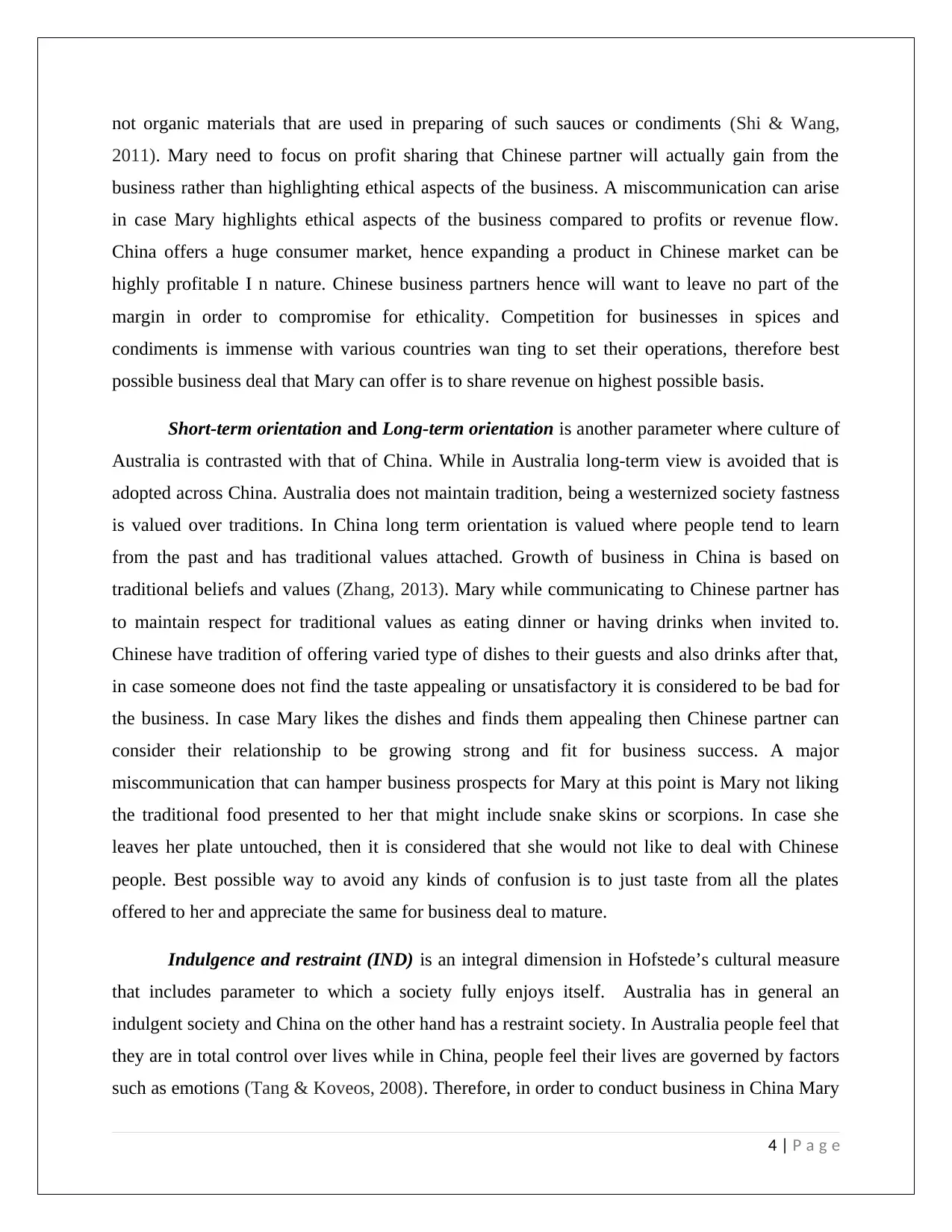
not organic materials that are used in preparing of such sauces or condiments (Shi & Wang,
2011). Mary need to focus on profit sharing that Chinese partner will actually gain from the
business rather than highlighting ethical aspects of the business. A miscommunication can arise
in case Mary highlights ethical aspects of the business compared to profits or revenue flow.
China offers a huge consumer market, hence expanding a product in Chinese market can be
highly profitable I n nature. Chinese business partners hence will want to leave no part of the
margin in order to compromise for ethicality. Competition for businesses in spices and
condiments is immense with various countries wan ting to set their operations, therefore best
possible business deal that Mary can offer is to share revenue on highest possible basis.
Short-term orientation and Long-term orientation is another parameter where culture of
Australia is contrasted with that of China. While in Australia long-term view is avoided that is
adopted across China. Australia does not maintain tradition, being a westernized society fastness
is valued over traditions. In China long term orientation is valued where people tend to learn
from the past and has traditional values attached. Growth of business in China is based on
traditional beliefs and values (Zhang, 2013). Mary while communicating to Chinese partner has
to maintain respect for traditional values as eating dinner or having drinks when invited to.
Chinese have tradition of offering varied type of dishes to their guests and also drinks after that,
in case someone does not find the taste appealing or unsatisfactory it is considered to be bad for
the business. In case Mary likes the dishes and finds them appealing then Chinese partner can
consider their relationship to be growing strong and fit for business success. A major
miscommunication that can hamper business prospects for Mary at this point is Mary not liking
the traditional food presented to her that might include snake skins or scorpions. In case she
leaves her plate untouched, then it is considered that she would not like to deal with Chinese
people. Best possible way to avoid any kinds of confusion is to just taste from all the plates
offered to her and appreciate the same for business deal to mature.
Indulgence and restraint (IND) is an integral dimension in Hofstede’s cultural measure
that includes parameter to which a society fully enjoys itself. Australia has in general an
indulgent society and China on the other hand has a restraint society. In Australia people feel that
they are in total control over lives while in China, people feel their lives are governed by factors
such as emotions (Tang & Koveos, 2008). Therefore, in order to conduct business in China Mary
4 | P a g e
2011). Mary need to focus on profit sharing that Chinese partner will actually gain from the
business rather than highlighting ethical aspects of the business. A miscommunication can arise
in case Mary highlights ethical aspects of the business compared to profits or revenue flow.
China offers a huge consumer market, hence expanding a product in Chinese market can be
highly profitable I n nature. Chinese business partners hence will want to leave no part of the
margin in order to compromise for ethicality. Competition for businesses in spices and
condiments is immense with various countries wan ting to set their operations, therefore best
possible business deal that Mary can offer is to share revenue on highest possible basis.
Short-term orientation and Long-term orientation is another parameter where culture of
Australia is contrasted with that of China. While in Australia long-term view is avoided that is
adopted across China. Australia does not maintain tradition, being a westernized society fastness
is valued over traditions. In China long term orientation is valued where people tend to learn
from the past and has traditional values attached. Growth of business in China is based on
traditional beliefs and values (Zhang, 2013). Mary while communicating to Chinese partner has
to maintain respect for traditional values as eating dinner or having drinks when invited to.
Chinese have tradition of offering varied type of dishes to their guests and also drinks after that,
in case someone does not find the taste appealing or unsatisfactory it is considered to be bad for
the business. In case Mary likes the dishes and finds them appealing then Chinese partner can
consider their relationship to be growing strong and fit for business success. A major
miscommunication that can hamper business prospects for Mary at this point is Mary not liking
the traditional food presented to her that might include snake skins or scorpions. In case she
leaves her plate untouched, then it is considered that she would not like to deal with Chinese
people. Best possible way to avoid any kinds of confusion is to just taste from all the plates
offered to her and appreciate the same for business deal to mature.
Indulgence and restraint (IND) is an integral dimension in Hofstede’s cultural measure
that includes parameter to which a society fully enjoys itself. Australia has in general an
indulgent society and China on the other hand has a restraint society. In Australia people feel that
they are in total control over lives while in China, people feel their lives are governed by factors
such as emotions (Tang & Koveos, 2008). Therefore, in order to conduct business in China Mary
4 | P a g e
Secure Best Marks with AI Grader
Need help grading? Try our AI Grader for instant feedback on your assignments.
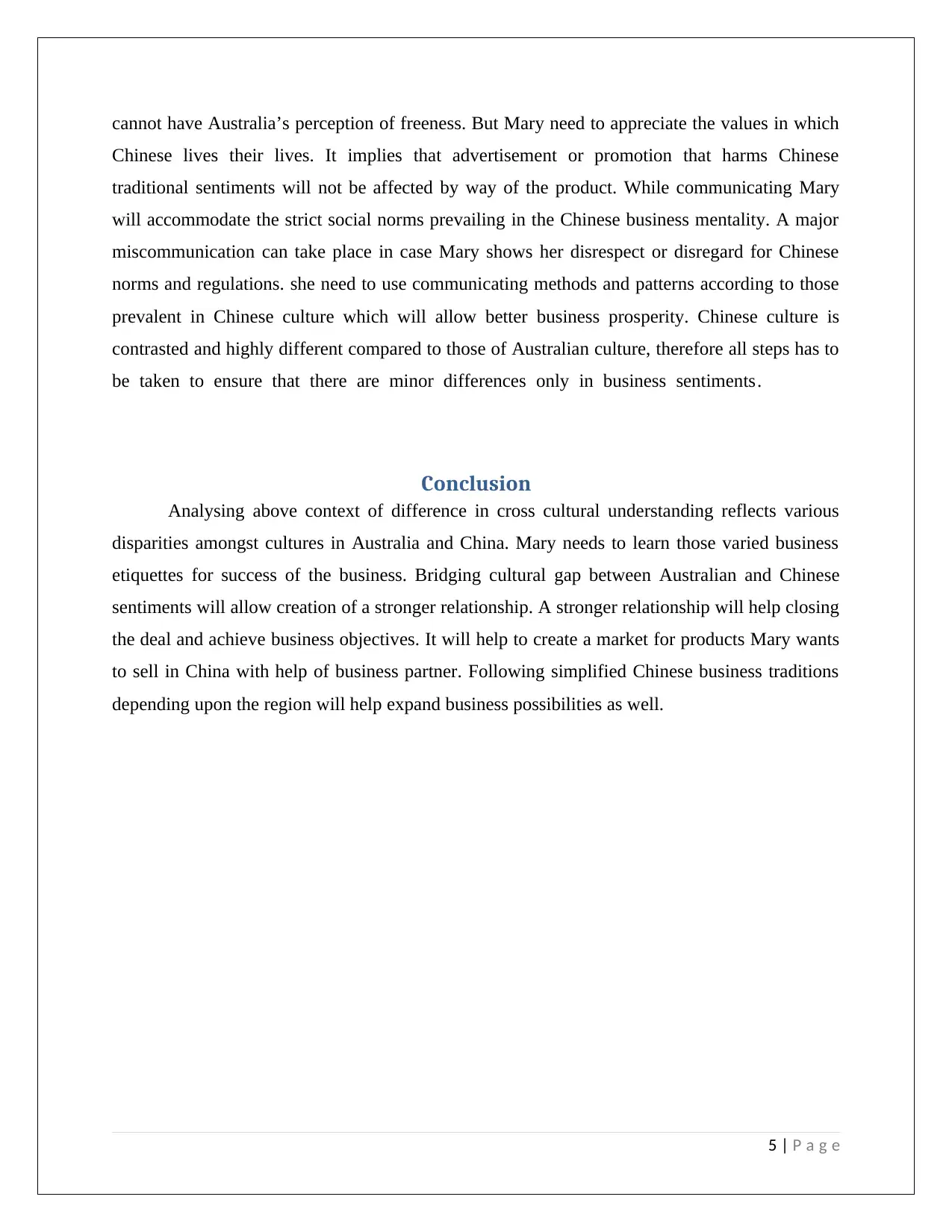
cannot have Australia’s perception of freeness. But Mary need to appreciate the values in which
Chinese lives their lives. It implies that advertisement or promotion that harms Chinese
traditional sentiments will not be affected by way of the product. While communicating Mary
will accommodate the strict social norms prevailing in the Chinese business mentality. A major
miscommunication can take place in case Mary shows her disrespect or disregard for Chinese
norms and regulations. she need to use communicating methods and patterns according to those
prevalent in Chinese culture which will allow better business prosperity. Chinese culture is
contrasted and highly different compared to those of Australian culture, therefore all steps has to
be taken to ensure that there are minor differences only in business sentiments.
Conclusion
Analysing above context of difference in cross cultural understanding reflects various
disparities amongst cultures in Australia and China. Mary needs to learn those varied business
etiquettes for success of the business. Bridging cultural gap between Australian and Chinese
sentiments will allow creation of a stronger relationship. A stronger relationship will help closing
the deal and achieve business objectives. It will help to create a market for products Mary wants
to sell in China with help of business partner. Following simplified Chinese business traditions
depending upon the region will help expand business possibilities as well.
5 | P a g e
Chinese lives their lives. It implies that advertisement or promotion that harms Chinese
traditional sentiments will not be affected by way of the product. While communicating Mary
will accommodate the strict social norms prevailing in the Chinese business mentality. A major
miscommunication can take place in case Mary shows her disrespect or disregard for Chinese
norms and regulations. she need to use communicating methods and patterns according to those
prevalent in Chinese culture which will allow better business prosperity. Chinese culture is
contrasted and highly different compared to those of Australian culture, therefore all steps has to
be taken to ensure that there are minor differences only in business sentiments.
Conclusion
Analysing above context of difference in cross cultural understanding reflects various
disparities amongst cultures in Australia and China. Mary needs to learn those varied business
etiquettes for success of the business. Bridging cultural gap between Australian and Chinese
sentiments will allow creation of a stronger relationship. A stronger relationship will help closing
the deal and achieve business objectives. It will help to create a market for products Mary wants
to sell in China with help of business partner. Following simplified Chinese business traditions
depending upon the region will help expand business possibilities as well.
5 | P a g e
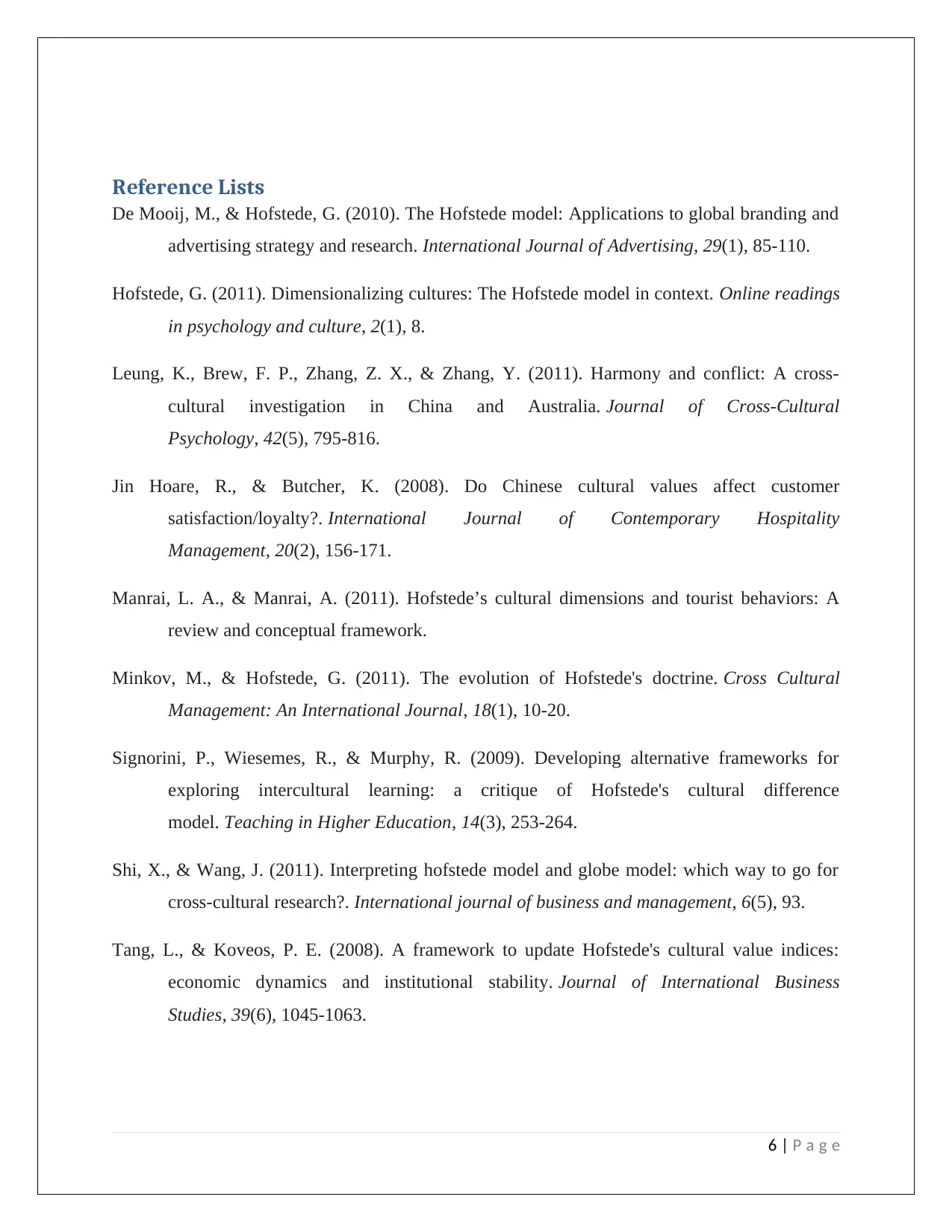
Reference Lists
De Mooij, M., & Hofstede, G. (2010). The Hofstede model: Applications to global branding and
advertising strategy and research. International Journal of Advertising, 29(1), 85-110.
Hofstede, G. (2011). Dimensionalizing cultures: The Hofstede model in context. Online readings
in psychology and culture, 2(1), 8.
Leung, K., Brew, F. P., Zhang, Z. X., & Zhang, Y. (2011). Harmony and conflict: A cross-
cultural investigation in China and Australia. Journal of Cross-Cultural
Psychology, 42(5), 795-816.
Jin Hoare, R., & Butcher, K. (2008). Do Chinese cultural values affect customer
satisfaction/loyalty?. International Journal of Contemporary Hospitality
Management, 20(2), 156-171.
Manrai, L. A., & Manrai, A. (2011). Hofstede’s cultural dimensions and tourist behaviors: A
review and conceptual framework.
Minkov, M., & Hofstede, G. (2011). The evolution of Hofstede's doctrine. Cross Cultural
Management: An International Journal, 18(1), 10-20.
Signorini, P., Wiesemes, R., & Murphy, R. (2009). Developing alternative frameworks for
exploring intercultural learning: a critique of Hofstede's cultural difference
model. Teaching in Higher Education, 14(3), 253-264.
Shi, X., & Wang, J. (2011). Interpreting hofstede model and globe model: which way to go for
cross-cultural research?. International journal of business and management, 6(5), 93.
Tang, L., & Koveos, P. E. (2008). A framework to update Hofstede's cultural value indices:
economic dynamics and institutional stability. Journal of International Business
Studies, 39(6), 1045-1063.
6 | P a g e
De Mooij, M., & Hofstede, G. (2010). The Hofstede model: Applications to global branding and
advertising strategy and research. International Journal of Advertising, 29(1), 85-110.
Hofstede, G. (2011). Dimensionalizing cultures: The Hofstede model in context. Online readings
in psychology and culture, 2(1), 8.
Leung, K., Brew, F. P., Zhang, Z. X., & Zhang, Y. (2011). Harmony and conflict: A cross-
cultural investigation in China and Australia. Journal of Cross-Cultural
Psychology, 42(5), 795-816.
Jin Hoare, R., & Butcher, K. (2008). Do Chinese cultural values affect customer
satisfaction/loyalty?. International Journal of Contemporary Hospitality
Management, 20(2), 156-171.
Manrai, L. A., & Manrai, A. (2011). Hofstede’s cultural dimensions and tourist behaviors: A
review and conceptual framework.
Minkov, M., & Hofstede, G. (2011). The evolution of Hofstede's doctrine. Cross Cultural
Management: An International Journal, 18(1), 10-20.
Signorini, P., Wiesemes, R., & Murphy, R. (2009). Developing alternative frameworks for
exploring intercultural learning: a critique of Hofstede's cultural difference
model. Teaching in Higher Education, 14(3), 253-264.
Shi, X., & Wang, J. (2011). Interpreting hofstede model and globe model: which way to go for
cross-cultural research?. International journal of business and management, 6(5), 93.
Tang, L., & Koveos, P. E. (2008). A framework to update Hofstede's cultural value indices:
economic dynamics and institutional stability. Journal of International Business
Studies, 39(6), 1045-1063.
6 | P a g e
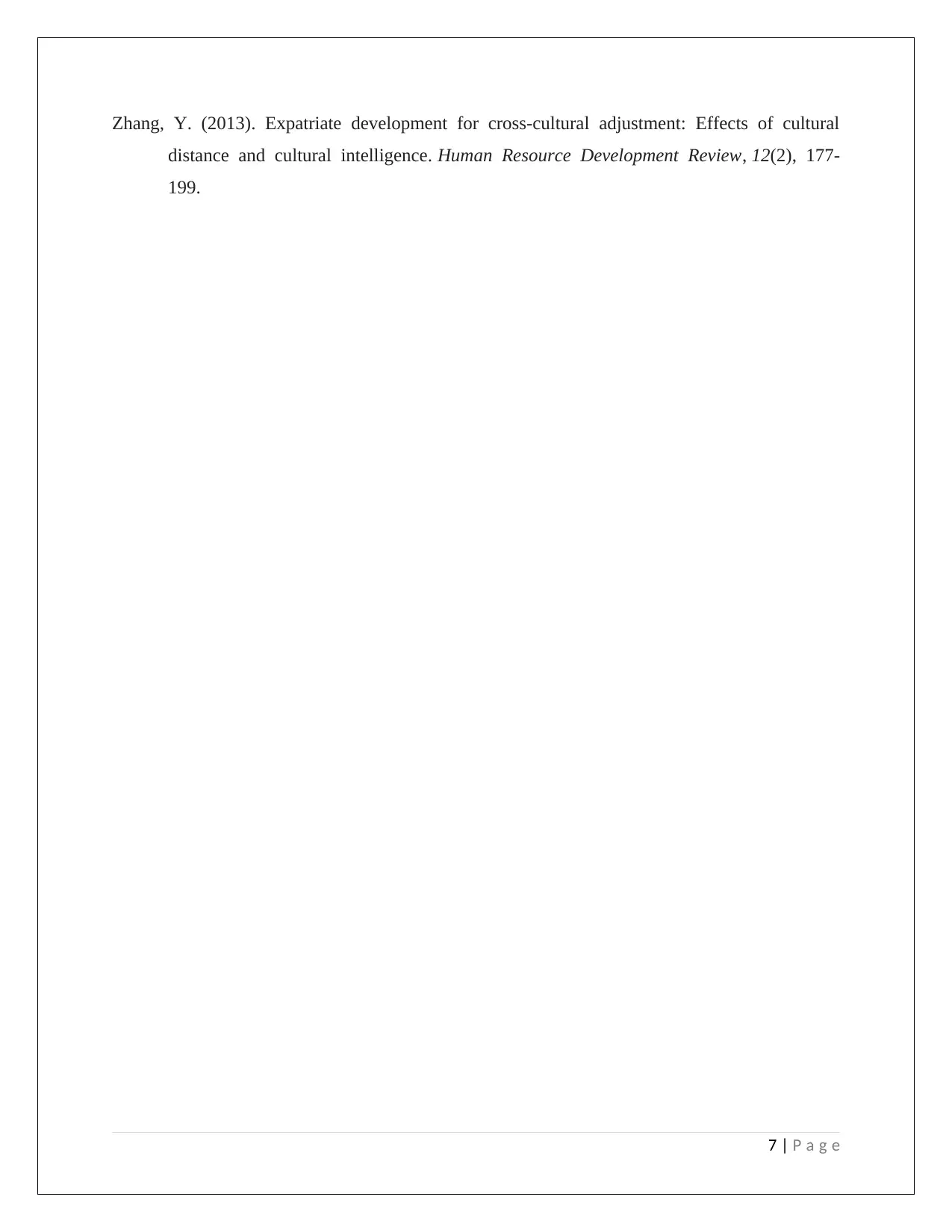
Zhang, Y. (2013). Expatriate development for cross-cultural adjustment: Effects of cultural
distance and cultural intelligence. Human Resource Development Review, 12(2), 177-
199.
7 | P a g e
distance and cultural intelligence. Human Resource Development Review, 12(2), 177-
199.
7 | P a g e
1 out of 7
Related Documents
Your All-in-One AI-Powered Toolkit for Academic Success.
+13062052269
info@desklib.com
Available 24*7 on WhatsApp / Email
![[object Object]](/_next/static/media/star-bottom.7253800d.svg)
Unlock your academic potential
© 2024 | Zucol Services PVT LTD | All rights reserved.




